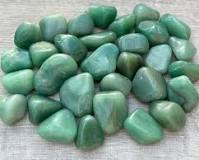
Aventurine: The Earth’s Whisper of Prosperity and Peace
Amongst the crystal world’s many green guardians, Aventurine stands out as a vibrant yet grounding ally—beloved for its lush colour, energetic optimism, and speckled shimmer. Often called the “Stone of Opportunity,” Aventurine bridges Earth’s nurturing frequency with a spirited sense of abundance and renewal. For crystal collectors, jewellery artisans, and spiritual seekers alike, this raw mineral offers much more than meets the eye.
Geological Profile: Structure, Composition & Origins
Aventurine is a form of quartz, specifically a microcrystalline variety, characterised by inclusions of mica or other minerals that give it a distinctive glittery effect, known as aventurescence. This phenomenon is subtle in some pieces and vivid in others, creating a natural sparkle that draws both the eye and the spirit.
Key Properties:
-
Chemical Composition: Primarily silicon dioxide (SiO₂), with inclusions of mica (fuchsite in green varieties), hematite, or goethite.
-
Crystal System: Trigonal
-
Mohs Hardness: 6.5 to 7, making it durable enough for everyday wear
-
Common Colours: Most famously green, though Aventurine can also appear in blue, red-orange, peach, brown, and grey tones depending on its mineral inclusions.
-
Major Sources: India (particularly Tamil Nadu), Brazil, Russia, Chile, and Spain. The highest-quality green Aventurine—with its saturated colour and fine shimmer—is typically sourced from India.

Energetic Properties and Healing Meaning
Aventurine is frequently associated with the heart chakra, making it a key stone for emotional balance, healing, and vitality. Green Aventurine in particular is revered for its resonance with:
-
Abundance and prosperity: Often used in manifestation rituals for wealth or new ventures.
-
Emotional calm: Soothes anxiety, promotes inner harmony, and softens critical self-talk.
-
Growth and renewal: Aligns with the energy of Spring, making it ideal for those embracing change or personal development.
-
Optimism and resilience: Encourages a hopeful outlook, especially during transitions or healing phases.
Metaphysically, Aventurine is seen as a gentle amplifier—it doesn’t overwhelm the energetic field, but rather supports and sustains one’s intentions. Its soft sparkle reminds the wearer that subtle shifts often create lasting change.
The Natural Form: Why Raw Aventurine Matters
While polished Aventurine is readily found in tumblestones and beads, raw Aventurine offers a deeper connection to the Earth’s original voice. In its natural, unshaped form, Aventurine retains more of its grounding frequency, untouched by industrial processing. This makes it a powerful component in mineral specimen jewellery, where the crystal is celebrated for its organic geometry and tactile authenticity.
Collectors and conscious wearers alike find value in raw Aventurine’s:
-
Varied texture and surface shimmer
-
Unique mineral layering that reveals mica inclusions
-
Energy that feels more primal and elemental than its polished counterpart
In jewellery, it pairs beautifully with copper or brushed gold finishes that echo its earthy essence.
Aventurine in History and Cultural Symbolism
While Aventurine may not hold the same mythic status as lapis lazuli or emeralds, it has quietly woven its way through centuries of human interaction with the natural world. In ancient Tibet, green Aventurine was used in statues to symbolise the eyes, believed to increase visionary powers and inner sight. The stone was also associated with the spirit of spring and renewal in Chinese folklore, symbolising opportunity and upward movement.
Its name comes from the Italian word “a ventura”, meaning “by chance”—an echo of both its sparkling appearance and its alignment with serendipity and fortune.
Comparisons with Similar Crystals
Aventurine is sometimes mistaken for jade or amazonite due to its green hue. However, its identity is distinct in both composition and energetic feel:
-
Versus Jade: Aventurine is more translucent and sparkly due to mica, while jade tends to be waxier and more opaque. Aventurine is associated with luck and growth, whereas jade traditionally aligns with harmony and protection.
-
Versus Amazonite: Amazonite often carries blue-green tones and has a more calming energy, whereas Aventurine leans into the motivational and uplifting spectrum.
-
Versus Green Quartz: While both are quartz-based, Aventurine’s aventurescence and mica inclusions distinguish it visually and energetically.
Aventurine in Jewellery Design: Celebrating Raw Beauty
In the realm of raw crystal jewellery, Aventurine finds a poetic place. Its natural shimmer and earthy green depth make it an ideal centrepiece for:
-
Crystal specimen rings: Where asymmetry and texture bring authenticity to every piece.
-
Mineral specimen necklaces: Pairing raw Aventurine with warm metals or complementary crystals like moonstone or citrine.
-
Handmade gemstone rings: Often left unpolished to retain the stone’s grounding vibration and unique form.
For wearers, such jewellery isn’t just decorative—it becomes a tool for alignment, encouragement, and self-trust.

At Oryssia, Aventurine is occasionally featured in its raw, organic form, chosen for its wild shimmer and heart-opening essence. Each specimen is a quiet teacher, reminding us to say yes to growth, beauty, and transformation.